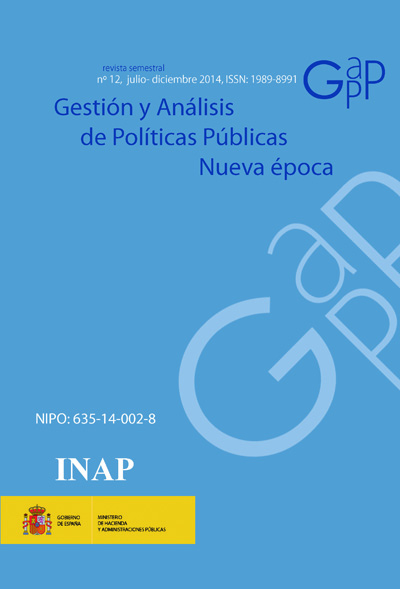Potencialidad y limitaciones del modelo de diferencias en diferencias aplicado con datos agregados a la evaluación de políticas públicas en el ámbito territorial
DOI:
https://doi.org/10.24965/gapp.v0i12.10204Palabras clave:
Políticas públicas, evaluación de programas, modelo de diferencias en diferenciasResumen
El objetivo del presente artículo es la ilustración de la potencialidad del Modelo de Diferencias en Diferencias (DiD) para la evaluación de diversas políticas públicas aplicadas en el ámbito territorial y utilizando datos agregados. Con esta finalidad se ha realizado una panorámica general sobre las alternativas de evaluación de políticas públicas y revisado las posibilidades de aplicación sobre un amplio espectro de políticas desarrolladas en la comunidad autónoma del País Vasco. A continuación, se presenta la metodología básica de los modelos de diferencias en diferencias y se realizarán dos aplicaciones alternativas, una de ámbito local, el Programa Izartu, y otra de ámbito regional, el Programa Euskadi de fomento de la sociedad de la información con el fin de ilustrar la potencialidad y limitaciones de la metodología propuestas. El artículo finaliza con un apartado dedicado a la valoración de los resultados obtenidos y con una propuesta para la corrección de los principales problemas metodológicos identificados vinculados con el cumplimiento de la condición de tendencia paralela.
Descargas
Citas
Acs, G., & Nelson, S. (2004). Changes in living arrangements during the late 1990s: do welfare policies matter?. Journal of Policy Analysis and Management, 23(2), 273-290.
Banzhaf, H.S. y Walsh, R. (2006): “Do People Vote with Their Feet? An Empirical Test of Environmental Gentrification”, Resources For the Future, Discussion Papers. http://www.rff.org/documents/RFF-DP-06-10.pdf
Bertrand, M., Duflo, E., & Mullainathan, S. (2004). How much should we trust differences-in-differences estimates?. The Quarterly Journal of Economics, 119(1), 249-275.
Blundell, R., Dias, M. C., Meghir, C., & Reenen, J. (2004). Evaluating the employment impact of a mandatory job search program. Journal of the European Economic Association, 2(4), 569-606.
Blundell, R., Duncan, A., & Meghir, C. (1998). Estimating labor supply responses using tax reforms. Econometrica, 66(4), 827-861.
Card, D. (1989). The impact of the Mariel boatlift on the Miami labor market (No. w3069). National Bureau of Economic Research.
Card, D., & Krueger, A. B. (2000). Minimum wages and employment: a case study of the fast-food industry in New Jersey and Pennsylvania: reply. American Economic Review, 90(5), 1397-1420.
Domino, M. E., Norton, E. C., Morrissey, J. P., & Thakur, N. (2004). Cost shifting to jails after a change to managed mental health care. Health Services Research, 39(5), 1379-1402.
Douglas, S. (2006). Measuring Gains from Regional Dispatch: Coal-Fired Power Plant Utilization and Market Reforms. Energy Journal, 27(1), 119-138.
Duflo, E. (2000). Schooling and labor market consequences of school construction in Indonesia: Evidence from an unusual policy experiment (No. w7860). National Bureau of Economic Research.
Eissa, N., & Liebman, J. B. (1996). Labor supply response to the earned income tax credit. The Quarterly Journal of Economics, 111(2), 605-637.
Feder, G., Murgai, R., & Quizon, J. B. (2004). Sending farmers back to school: The impact of farmer field schools in Indonesia. Applied Economic Perspectives and Policy, 26(1), 45-62.
García Gómez, P. (2005). Evaluación de un programa de atención dental público: PADI en el País Vasco. Ekonomiaz, 60(2), 62-89.
Girma, S., & Görg, H. (2007). Evaluating the foreign ownership wage premium using a difference-in-differences matching approach. Journal of International Economics, 72(1), 97-112.
Gorg, H., & Strobl, E. (2005). Do government subsidies stimulate training expenditure? Microeconometric evidence from plant level data. Discusion Paper Series nº 1606. Institute for the Study of Labor.
Gruber, J., & Madrian, B. C. (1994). Health insurance and job mobility: The effects of public policy on job-lock. Industrial and Labor Relations Review, 48(1), 86-102.
Hamermesh, D. S., & Scoones, W. D. (1999). Policy equilibria in a federal system: the effects of higher tax ceilings for unemployment insurance. Journal of Public Economics, 74(2), 191-213.
Hansson, A. (2008). The wealth tax and entrepreneurial activity. Journal of Entrepreneurship, 17(2), 139-156.
Heckman, J. J., LaLonde, R. J., & Smith, J. A. (1999). The economics and econometrics of active labor market programs. Handbook of labor economics, 3(A), 1865-2097.
Hoynes, H. W., Gelbach, J. B., & Bitter, M. P. (2005). Welfare Reform and Health. Journal of human resources, 40(2), 309-334.
Konetzka, R. T., Yi, D., Norton, E. C., & Kilpatrick, K. E. (2004). Effects of Medicare payment changes on nursing home staffing and deficiencies. Health services research, 39(3), 463-488.
Liu, Z., Dow, W. H., & Norton, E. C. (2004). Effect of drive-through delivery laws on postpartum length of stay and hospital charges. Journal of Health Economics, 23(1), 129-155.
Neumark, D., & Wascher, W. (2003). Minimum wages and skill acquisition: Another look at schooling effects. Economics of Education Review, 22(1), 1-10.
Planas Miret, I. (2005). Principales mecanismos de evaluación económica de políticas públicas. Ekonomiaz, 60(1), 98-121.
Puhani, P. A. (2012). The treatment effect, the cross difference, and the interaction term in nonlinear “difference-in-differences” models. Economics Letters, 115(1), 85-87.
Pulido, A., López, A.M., Sánchez, J.C. y Lázarich, R. (2001): “Actuaciones regionales para la implantación de empresas”, Documentos N-economía. Ceprede. Madrid.
Rubb, S. (2003). Social Security’s Earnings Test Penalty and the Employment Rates of Elderly Men Aged 65 to 69. Eastern Economic Journal, 29(3), 415-431.
Shen, Y. C., & Zuckerman, S. (2005). The effect of Medicaid payment generosity on access and use among beneficiaries. Health Services Research, 40(3), 723-744.
Shapiro, J., & Skoufias, E. (2006). Evaluating the impact of Mexico’s Quality Schools Program: The pitfalls of using nonexperimental data. World Bank Policy Research Working Paper 4036, October 2006
Smith, J., & Todd, P. (2005). Does matching overcome LaLonde’s critique of nonexperimental estimators?. Journal of econometrics, 125(1), 305-353.
Song, J. G. (2003). Evaluating the initial impact of eliminating the retirement earnings test. Social Security Bulletin, 65(1), 1-15.
Ten Cate, A. (2003). The Impact of Provincial Maternity and Parental Leave Policies on Employment Rates of Women with Young Children in Canada (No. 2003-03).












